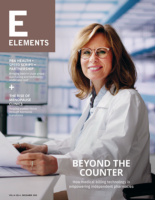The success of your independent community pharmacy relies on properly managing your most valuable assets.
Your pharmacy has many assets. Some are tangible assets, such as your inventory, computers, pill counters, and shelving. Others are intangible assets. These can include your reputation and your brand.
In any small business, properly managing — and capitalizing on — your best assets can make a big difference when it comes to the success of your business.
Knowing where to start when it comes to making the most of your assets can be a daunting task. Let’s start by defining what we see as some of your independent community pharmacy’s most valuable assets.
Time
For the typical retail pharmacy, there are only 12 hours in a workday, which is likely never enough time to complete everything on your “to-do” list.
If you’re not properly managing your time and your employees’ time, you could be squandering one of your most valuable — and scarce — assets.
Get the most out of the time you have by creating a list of your top priorities, delegating duties to trusted employees, and leveraging technology to automate more tasks.
For example, investing in pharmacy automation can free up you and your employees’ time to work on tasks that can’t be automated, such as counseling patients. Robotics can fill a huge chunk of your pharmacy’s daily volume, freeing up your employees to work on more productive and profitable tasks.
People
Your employees are valuable assets for your pharmacy. You invest your time and financial resources to train them.
Start maximizing your human capital by making sure you get the right person for the right job when you hire new employees. Get the most out of employees’ time by making sure that they’re never without something to do while at your pharmacy.
Don’t forget to maximize what your employees can contribute. For example, make sure you’re using your staff pharmacist to fill scripts, counsel patients, and provide patient care services. Leave duties such as cleaning and restocking your front end to non-pharmacy employees.
Keep an eye out for issues that could be affecting employees’ productivity — like constant workplace interruptions, old technology, too much micromanagement, and overall low morale — and work to mitigate any problems.
And ask your employees for ideas about ways your pharmacy can improve. Your employees might have great insights about new products or services you can offer.
Inventory
The vast majority of your expenses go toward your inventory, which means you should make sure the items on your shelves are working for you.
That means implementing an efficient inventory management system to make sure you have the items your patients need without incurring excessive holding costs, risking expirations, or running out of a particular drug that patients need.
Keep track of your pharmacy’s inventory turnover rate to ensure your products are moving off the shelves the way they should. An ideal inventory management system will allow you to stock the minimum amount of inventory while still meeting your patients’ needs.
Pharmacy inventory is also unique because you have to balance the needs of your customers with the conditions of your pharmacy contract. In order to make the biggest profit off your inventory, you have to manage a complex arrangement of contract incentives and volume commitments that reward you with rebates. Wholesaler rebates can make a six-figure difference in a pharmacy’s bottom line, but the complexity of the commitments and ever-changing inventory needs can make it nearly impossible to track in real-time and to optimize.
Fortunately, ProfitGuard® can take those difficult decisions off your hands. ProfitGuard’s purchasing report arrives in your inbox every day to help you make smarter purchasing decisions. Using advanced proprietary technology, it continuously calculates your purchasing information, including every incentive and commitment in your wholesaler contract, and advises you on which NDCs to purchase from which suppliers so you can maximize your wholesaler rebates and take advantage of low prices.
With ProfitGuard, you won’t have to think twice about your purchasing, and you’ll save more money than you ever could on your own. Many ProfitGuard pharmacies who take advantage of the Navigation tool have achieved an average savings of 6 percent on their total prescription volume. For a pharmacy that has the NCPA-average cost of goods of $2,768,280, that’s a savings of $166,096 straight into your pocket.
“It’s the industry game changer for the independent pharmacy owner or operator,” says Huy Duong, owner of Dale’s Pharmacy in Colorado. “There’s nothing out there like it on the market.”
In the case that your primary wholesaler doesn’t have what you need, you’ll need a reliable secondary supplier waiting in the wings.
BuyLine®, an NABP-accredited secondary supplier, offers a full line of brands, generics, OTCs, and controls at the lowest prices in the secondary market. In addition to having low list prices, BuyLine also rewards purchases with cash rebates and significant discounts on brands. Earn up to an additional 10% cash rebate on generics and up to WAC -4% on brand.
Reputation
Your pharmacy likely has a reputation as a pillar of the community, or as a business that provides excellent customer service. Your status as an independent community pharmacy can attract patients to your business.
Your good reputation is a valuable tool to recruit new patients to your pharmacy, which makes it an important asset.
Strengthen your reputation in your community by volunteering at a local charity and attending community events. Also, consider reaching out to local media to talk about the importance of flu shots, or host a diabetes education event to promote your pharmacy’s health expertise.
Prove you understand your community by offering niche services that meet their specific needs. Whether it’s diabetes care, immunizations, or veterinary medicine, a niche service demonstrates that you care about the same things your community cares about.
By properly managing your reputation, you’ll attract new patients and strengthen your image with current patients.
Knowledge and expertise
Your pharmacists’ knowledge is one of your business’s greatest assets. It’s important to keep your employees’ knowledge up-to-date and to create opportunities to share it and showcase it.
Attending continuing education (CE) sessions is a great way to get up-to-date about the latest innovations in pharmacy, such as patient counseling techniques or genetic testing technology. CE sessions are not only a great way to hone skills you already have, but they’re also a chance to learn new ones and to grow professionally.
Maximize your knowledge by developing expertise in areas patients are interested in, such as nutrition, or in areas where there’s a growing demand, such as diabetes care and counseling.
Showcase your pharmacy’s expertise at a local health fair, or by setting up a booth at a 5k race.
Front-end space
You may be surprised to see your pharmacy’s front end as a valuable asset, but it is. Your front end is likely an area of untapped potential.
Make the most out of every inch of your pharmacy’s front-end shelf space by using proven merchandising techniques to encourage impulse purchases and to lure patients into your store to browse.
Maximize the use of your shelving space by offering high-margin products, such as compression hose or first aid and wound care products. Make sure you’re avoiding common merchandising mistakes, and take advantage of your most prominent spaces by featuring in-demand seasonal products that rotate, so patients see something new every time they visit your pharmacy.
If you aren’t sure where to start with your front end, planograms can be a great asset. These diagrams use industry research to determine where products should be placed on your front-end shelves to make you the biggest profit.
A Member-Owned Company Serving Independent Pharmacies
PBA Health is dedicated to helping independent pharmacies reach their full potential on the buy-side of their business. Founded and owned by pharmacists, PBA Health serves independent pharmacies with group purchasing services, wholesaler contract negotiations, proprietary purchasing tools, and more.
An HDA member, PBA Health operates its own NABP-accredited secondary wholesaler with more than 6,000 SKUs, including brands, generics, narcotics CII-CV, cold-storage products, and over-the-counter (OTC) products — offering the lowest prices in the secondary market.












